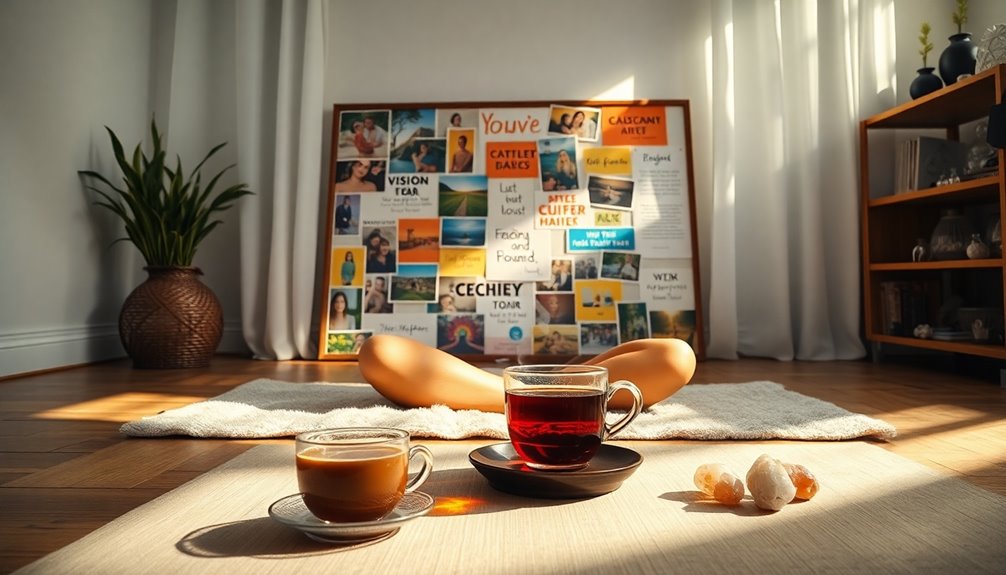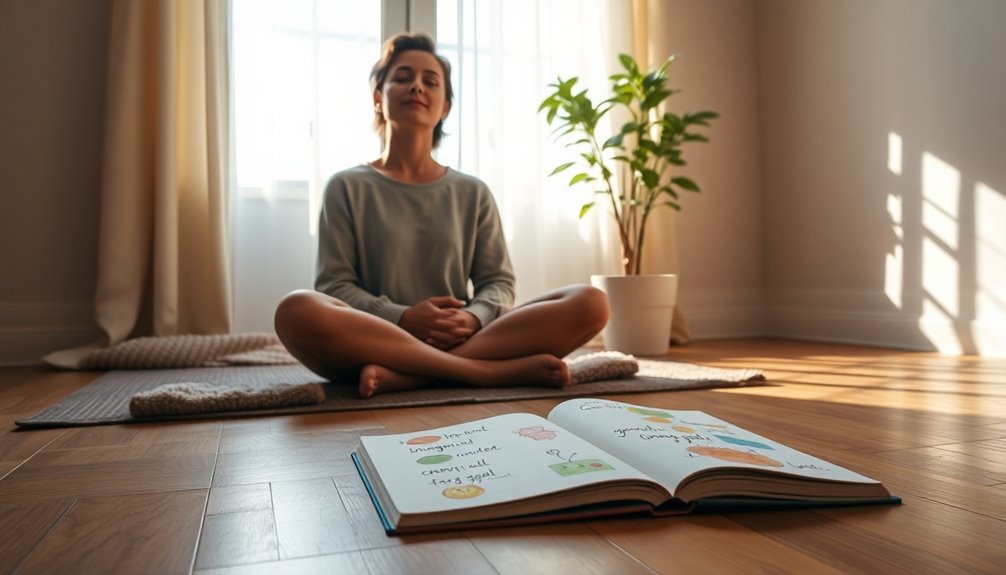Daily visualization exercises can greatly enhance your focus and mental clarity. Start by picturing a peaceful environment or imagine your day's goals to align your thoughts. Consistency is vital; choose a specific time to practice. Try using guided imagery to strengthen your concentration and boost motivation. Overcome challenges like distractions by creating a dedicated space for your practice. Track your progress by celebrating small victories and making adjustments along the way. These techniques not only improve focus but also promote overall well-being. Stick around to discover even more strategies that can elevate your visualization practice and boost your performance.
Key Takeaways
- Set a specific time each day to practice visualization, creating a consistent routine that enhances focus and mental clarity.
- Visualize serene environments or successful task completions to cultivate a positive mental space and enhance concentration.
- Use guided imagery techniques to reduce distractions and improve cognitive abilities during your visualization sessions.
- Track your progress by setting milestones and reflecting on improvements to stay motivated and focused on your goals.
- Incorporate visualization into your daily routine to boost self-confidence, reduce stress, and support overall health and well-being.
Understanding Visualization Techniques

Visualization techniques can transform your mental landscape, enhancing focus and clarity. You might be surprised at how effective techniques can help you harness the power of your imagination to achieve your goals. When you visualize, you're not just daydreaming; you're actively engaging with your mind to create a vivid picture of your desired outcome.
One effective technique is guided imagery. This involves closing your eyes and picturing a scenario where you excel, whether it's acing a presentation or performing well in a competition. By immersing yourself in this mental scene, you can evoke the emotions and sensations associated with success, reinforcing your confidence and motivation.
Another powerful technique is the use of vision boards. By gathering images and words that resonate with your aspirations, you create a tangible representation of your goals. Placing this board somewhere you see it daily serves as a constant reminder of what you're working toward, reinforcing the visualization benefits.
Don't underestimate the impact of consistent practice. The more you visualize, the more your brain becomes wired to recognize opportunities and pathways to achieve your goals. You're building a mental blueprint that guides your actions in the real world.
Embrace these visualization techniques, and watch how they reshape your focus and clarity. You're not alone in this journey; many share your desire for belonging and achievement. Together, you can access the incredible potential that lies within your mind.
Benefits of Daily Visualization

Incorporating daily visualization into your routine can greatly enhance your mental performance and overall well-being. When you take a few moments to visualize your goals, you're not just daydreaming; you're actively training your brain for success. This practice leads to improved concentration. By focusing on your desired outcomes, you sharpen your attention and minimize distractions, making it easier to stay on task throughout the day.
Moreover, visualization fosters enhanced mental clarity. As you picture your goals, you begin to clarify exactly what you want to achieve. This clear mental image helps you prioritize your actions, making decision-making feel more intuitive and focused.
You'll find that with regular practice, your thoughts become more organized, allowing you to tackle challenges with confidence. Additionally, visualizing your success can help you master the neurochemistry of flow, enabling you to enter a state of peak performance when needed.
In a world filled with noise and chaos, daily visualization offers you a sanctuary. It cultivates a sense of belonging, as you connect with your aspirations and align them with your true self. As you visualize, you create a supportive mental environment that encourages growth and resilience.
Simple Visualization Exercises

Harnessing the power of your imagination can transform your focus and productivity. Simple visualization exercises are effective visualization tools that you can easily incorporate into your daily routine. These practices help you tap into your mind's potential, creating a clearer path for your goals and tasks.
Start with a few minutes of quiet time. Close your eyes and take a deep breath. Picture a serene space, whether it's a beach, a forest, or a cozy room. As you visualize this environment, allow yourself to feel the calmness it brings. This simple act can clear mental clutter, helping you center your thoughts and enhance your focus.
Next, try a goal visualization practice. Imagine yourself successfully completing a task that's been on your mind. Visualize every detail: how you feel, the sounds around you, and the satisfaction of achievement. By creating this mental image, you're not just daydreaming; you're reinforcing your motivation and commitment to your goals.
Another effective exercise involves visualizing your day. Before diving into your tasks, spend a few moments picturing how you want your day to unfold. This proactive approach helps you mentally prepare and stay aligned with your intentions. Incorporating visualization can also support your journey to achieve health benefits like rapid fat loss, which can enhance your overall focus and productivity.
Incorporating these simple visualization exercises into your routine can foster a deeper sense of belonging in your journey toward focus and productivity. You're not alone; many share this path, and together, we can harness our imagination to achieve extraordinary things.
Creating a Visualization Routine

Building a visualization routine can be a game changer for your focus and productivity. When you incorporate mental imagery techniques into your daily life, you'll start to see a significant focus improvement. The key is consistency; by practicing visualization habits regularly, you're training your mind to stay on track and achieve your goals. Additionally, you may find that utilizing Brainwave Guidance Program can enhance your visualization practice and overall mental clarity.
To help you create an effective visualization routine, consider the following elements:
| Element | Description |
|---|---|
| Time of Day | Choose a consistent time, like morning or before bed. |
| Duration | Start with 5-10 minutes and gradually increase. |
| Environment | Find a quiet, comfortable space to minimize distractions. |
| Focus Area | Identify specific goals you want to visualize.
Overcoming Common Challenges

When you immerse yourself in visualization practices, you may encounter several common challenges that can hinder your progress. Recognizing these hurdles is vital, as acknowledging them is the first step toward overcoming them. Here are some typical mental obstacles you might face:
- Difficulty concentrating: Your mind might wander, making it challenging to focus on your visualization.
- Negative self-talk: Doubts can creep in, telling you that you aren't good enough or that it won't work for you.
- Time constraints: Busy schedules can make it difficult to carve out time for your visualization routine.
- Emotional resistance: Sometimes, confronting your goals can bring up discomfort or fear.
To effectively tackle these obstacles, distraction management is crucial. Start by creating a calm environment free from interruptions. You can also set specific times for your exercises, turning them into a non-negotiable part of your day. When negative thoughts arise, counter them with positive affirmations to strengthen your belief in the process. Additionally, incorporating comprehensive strengthening techniques can enhance your overall focus and mental clarity.
Measuring Your Progress
Measuring your progress in visualization exercises is important to understanding how far you've come and where you need to focus next. By tracking improvements, you can identify what's working and what needs adjustment. Start by setting milestones for your visualization practice, whether it's visualizing for a certain number of minutes each day or achieving a specific mental clarity. These milestones provide tangible goals that keep you motivated and engaged.
Monitoring results is another critical aspect of measuring your progress. After each session, take a moment to jot down how you felt and any improvements you noticed. Were you able to concentrate better? Did your mental images become clearer? This reflection helps you connect your efforts with positive outcomes, reinforcing your commitment to the practice. Additionally, consider how the practice of visualization can support your overall health, especially in relation to fatty liver disease, as a healthy mind can positively influence physical well-being.
As you continue on this journey, reflecting on growth is essential. Look back at your notes regularly to see how much you've evolved. Perhaps at first, you struggled to visualize anything, but now you can conjure vivid images with ease. This journey isn't just about the destination; it's about celebrating every small victory along the way.
Tips for Enhanced Focus

Enhanced concentration is essential for maximizing the benefits of your visualization exercises. When you hone your ability to concentrate, you open up greater potential within yourself, making your visualization practice even more impactful. To help you stay focused, here are some effective techniques you can incorporate into your daily routine:
- Create a designated space: Set up a quiet, clutter-free area for your visualization exercises. This helps signal your brain that it's time to focus.
- Establish a regular routine: Consistency is key. Choose a specific time each day for your exercises, creating a habit that reinforces your focus.
- Limit disturbances: Silence your phone and close unnecessary tabs on your computer. This simple act can notably improve your concentration.
- Use guided visualization: Listening to a guided session can help you stay on track and maintain focus. Engaging your mind with structured guidance enhances your experience.
- Incorporate mini bands: Using mini bands for body sculpting can also be beneficial, as they provide a unique challenge and help improve overall body awareness, further enhancing your visualization practice.
Frequently Asked Questions
Can Visualization Help With Anxiety and Stress Management?
Absolutely, visualization can be a powerful tool for managing anxiety and stress. By using visualization techniques, you create mental imagery that transports you to a calming place, helping you relax. This practice not only enhances your coping strategies but also allows you to reframe stressful situations.
When you regularly engage in these techniques, you'll find it easier to face challenges with a clearer mind and a more positive outlook.
You've got this!
How Long Does It Take to See Results From Visualization?
Think of visualization like planting a seed; with care, it'll grow. The visualization timeline for seeing results can vary, but many notice a positive impact on their mental health within a few weeks. By consistently practicing visualization, you're nurturing your mind, which leads to greater focus and clarity.
Is Visualization Effective for All Age Groups?
Absolutely, visualization can be effective for all age groups! For children, it supports child development by enhancing creativity and problem-solving skills.
Meanwhile, it can aid the elderly in maintaining cognition, helping to keep their minds sharp.
No matter your age, you can harness the power of visualization to achieve your goals. Embrace this technique and watch how it transforms your mindset, making you feel more connected and empowered in your journey.
Can Visualization Be Combined With Other Mindfulness Practices?
You know, combining visualization with other mindfulness practices is like peanut butter and jelly—perfect together! When you integrate visualization and meditation, you enhance your mental clarity and relaxation.
Similarly, pairing visualization and yoga can deepen your connection to your body and breath. So, why not give it a shot? By blending these techniques, you'll create a richer experience, helping you feel more centered and focused in your daily life.
What Should I Do if I Struggle to Visualize?
If you struggle to visualize, don't worry; you're not alone. Start by exploring different visualization techniques, like guided imagery or vision boards, to find what resonates with you. Overcoming obstacles takes practice, so be patient with yourself.
Try incorporating sensory details—imagine sounds, smells, and feelings related to your visualization. Surround yourself with supportive people who encourage your journey. Remember, it's about progress, not perfection, and each step brings you closer to your goals.
Conclusion
Incorporating daily visualization exercises can truly sharpen your focus and transform your mindset. Remember, "Practice makes perfect"—the more you visualize, the clearer your goals become. By creating a routine and tackling challenges head-on, you'll pave the way for success. As you measure your progress, celebrate the small victories, and keep pushing forward. Embrace the power of your imagination, and watch as your productivity soars. Start your journey today; your focused future awaits!



